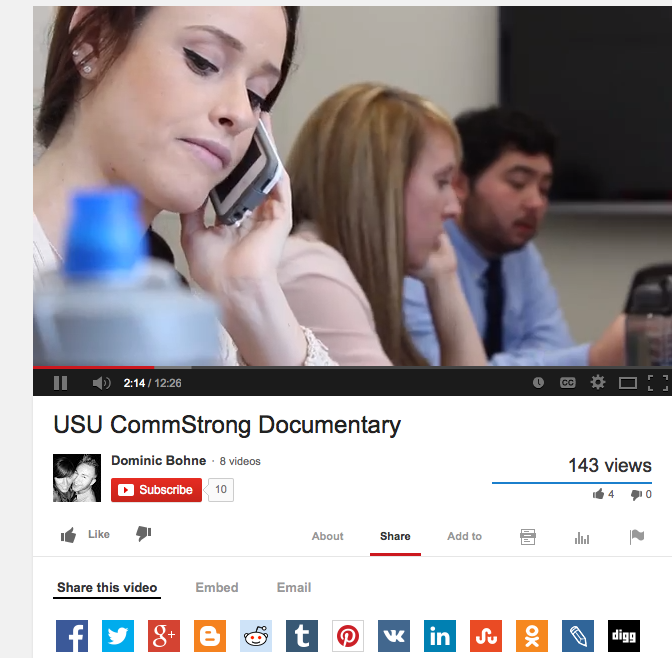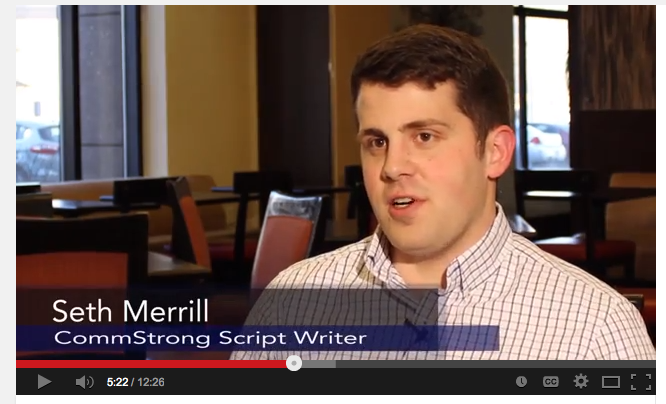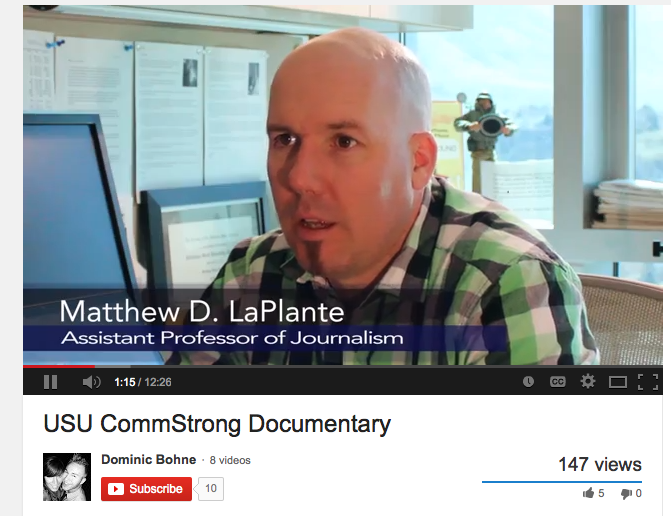Crisis simulation is rite of passage for JCOM journalists, PR students
May 12th, 2014 Posted in Arts and Life LOGAN—CRISIS! Teams of dozens of USU journalism and public relations students were thrown into the deep end of their professions in the third annual CommStrong crisis simulation exercise, a day-long trial by fire in which future communication professionals react to bombings, car crashes and municipal emergencies—all at once
LOGAN—CRISIS! Teams of dozens of USU journalism and public relations students were thrown into the deep end of their professions in the third annual CommStrong crisis simulation exercise, a day-long trial by fire in which future communication professionals react to bombings, car crashes and municipal emergencies—all at once
CommStrong is a professional training workshop developed by JCOM assistant professor Matthew D. LaPlante, and sponsored by the journalism & communication department.
“All I really want for students to do in CommStrong is to approach it the way they would if they were really in that situation,” LaPlante said. “Everything on top of that is gravy. If they do great, that’s great, that’s wonderful to see. If they do really poorly, that’s good too, because there’s learning there—there’s opportunity to learn from their mistakes.
“There are trials and tribulations, and it gives them the opportunity to see themselves in these situations and assess themselves, figure out what they need to do to get better that those things.”
LaPlante and his teaching assistants spend weeks developing the scenarios for various catastrophes that strike the USU campus and the Logan community. A bomb explodes, killing about two dozen people, and sending another 100 to area hospitals. Print and broadcast journalists working for competing news organizations swing into action to make sense of what’s happening and trying to beat the competition to get complete and accurate information to a frightened community, using traditional media as well as Twitter, the Web and other social media.
• Click on window below for 12-minute documentary by JCOM student Dominic Bohne on the 2014 CommStrong simulation
“CommStrong teaches students to make decisions quickly and effectively and ethically,” said multimedia and video assistant professor Chris Garff. “They have to think about each of those things, and it gives students experience that they’re not going to get unless they’re in this situation.
“Fortunately, it’s just a simulation, so they can make the mistakes now,” he said, “so when they go into the real world and they have a crisis, they don’t have to make the mistakes then. It’s a great test for students to see if they really want to go into this industry—if they can thrive in CommStrong, they’re going to thrive in the real world.”
While the competing journalist teams scrambled all across campus to get the story, other crises broke in to distract them. Do we stick with the bombing, or should we cover this car crash with multiple fatalities? In the real world, news stories often compete and overlap, so multi-tasking and level-headedness are essential professional skills.
 “If I could summarize CommStrong in one word, that word would be STRESS,” said Seth Merrill, one of the CommStrong script writers. “We’d be fooling ourselves if we went through school and never had to undergo stressful situations, or if we didn’t have to meet deadlines on numerous projects at once. So I think it really mirrors the stress of our industry in that aspect.”
“If I could summarize CommStrong in one word, that word would be STRESS,” said Seth Merrill, one of the CommStrong script writers. “We’d be fooling ourselves if we went through school and never had to undergo stressful situations, or if we didn’t have to meet deadlines on numerous projects at once. So I think it really mirrors the stress of our industry in that aspect.”
Meanwhile, teams of public relations students representing the city, the university, the police department and various government entities are also scrambling to get truthful and complete information out while trying to help their clients manage the crisis.
Kara Rindlisbacher has been a key part of LaPlante’s CommStrong team for two years. This year, she ran the room where journalists and PR students called for sources—elected officials, doctors, the Utah National Guard and others. “I’ve been the puppet director,” she said. “The script-writing is hard. It’s daunting at first because you know you need a script to last eight hours, and these students are going fast, so you need a lot of material, and you need to anticipate as many questions from the students as you can.”
Merrill, another student helping organize the mammoth simulation, wasn’t sure he wanted anything to do with it at first.
“When I found out about it, I didn’t really know what it was and it didn’t appeal to me because it sounded really hard,” he said. “And at that point, Matthew LaPlante was still pretty terrifying. So I thought, I don’t know why I’d want to go through a whole day of that. But then you get in there and realize that it’s a pretty cool opportunity to network with other students that you go to school with, and see how they act as professionals, not just as students.
 “And I also feel like it’s a rite of passage if you’re in the JCOM Department,” he said. “It’s a necessary experience to have, because you might be in the wrong major and not even know it until you’re under pressure and have to produce meaningful and important content on the spot.”
“And I also feel like it’s a rite of passage if you’re in the JCOM Department,” he said. “It’s a necessary experience to have, because you might be in the wrong major and not even know it until you’re under pressure and have to produce meaningful and important content on the spot.”
Department head Tom Terry, a “bit player” in the scenarios who played multiple roles, agrees. “It teaches them to deal with the stress of the [news] media. It teaches them to multi-task. It teaches them to be able to balance multiple stories at the same time, and keep them all separate in their heads,” said Terry, a former newspaper owner and editor, “because that’s how it is in a real media environment.
At the end of a very long, 8-hour day, the CommStrong teams could be proud of how they coped with the stress of their chosen professions. And LaPlante was proud of them, too.
“I think students should participate because it is such a unique learning environment” LaPlante said. “It’s like nothing else we do here. I’m really proud of this department. I love how we put students in the midst of the industry. So if we have students who want to be journalists, we send them out to be journalists.”
TP
Tags: Chris Garff, CommStrong, JCOM Department, Kara Rindlisbacher, Matthew LaPlante, Seth Merrill, Tom Terry

Sorry, comments for this entry are closed at this time.